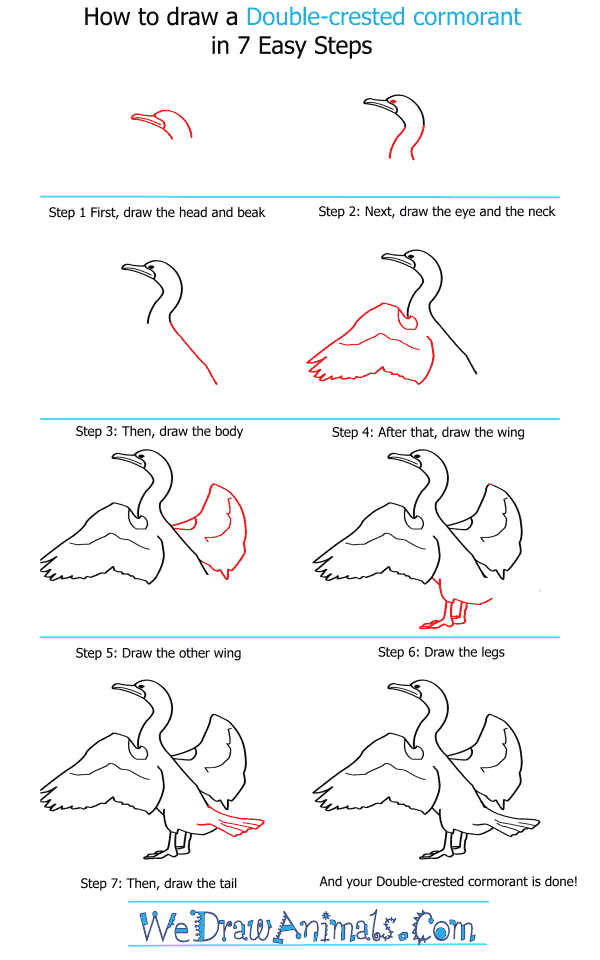In this quick tutorial you'll learn how to draw a Double Crested Cormorant in 7 easy steps - great for kids and novice artists.
The images above represent how your finished drawing is going to look and the steps involved.
Below are the individual steps - you can click on each one for a High Resolution printable PDF version.
At the bottom you can read some interesting facts about the Double Crested Cormorant.
Make sure you also check out any of the hundreds of drawing tutorials grouped by category.
How to Draw a Double Crested Cormorant - Step-by-Step Tutorial
Step 1: For the head, start by drawing a slightly downward curve. From the top end, start drawing another curve which then bumps up and outward at the midpoint of the first. At the midpoint of this curve, draw another, short curve which goes down and end near the end of the first curve. Draw a line inside this shape to define the beak—use the image if you need help.
Step 2: Draw a small dot over the end of the beak, and a curve coming down from each end of the head.
Step 3: Draw a line angling down from the back end of the neck.
Step 4: At the bottom end of the front of the neck, draw a large triangle with a zig-zagging bottom side. Draw a small curve where the triangle and neck meet, and an angle in the middle of the triangle.
Step 5: On the back, draw two curves which bend up and meet each other in a point. Draw a line in the middle of this shape and a curve at the point where the top curve meets the body.
Step 6: At the bottom of the first wing, draw a long downward curve. Under this curve, draw two lines straight down which then bend and close off, forming a backwards L. Make another backwards L for a pair of legs.
Step 7: Draw a straight line coming out from each end of the rear, and another straight line connecting the two. Draw several straight lines within this shape to define the tail feathers. Done! You can color it black.
Interesting Facts about Double-crested Cormorant
The Double-crested Cormorant is a yearlong resident in Florida and will migrate the rest of the United States and part of Central Canada where it will live during summer months. They are a common sight near fresh and saltwater.They look similar to a goose and a loon, they are relatives to frigates and boobies. They attract the most attention when standing on docks, rocky islands and channel markers spreading their wings out so they dry.
Did you know?
- The heavy boned bird is an expert at diving to catch small fish.
- The double crest is only visible on adults during breeding season. The crest is white in Alaska and black in other regions.
- Large pebbles are sometimes found in nests and treated as eggs.
- The oldest Double-crested Cormorant was 22 years old was banded in Ontario 1984 and found in Louisiana in 2006.
- Fecal matter can kill nest trees. When this happens the birds will move the nest to the ground or a new area.
The Double-crested Cormorant will often spread their wings in the sun to dry. The bird has less preen oil than ducks so their feathers get soaked instead of shedding it like a duck. While this may seem like a problem for the cormorant, they spend most of their time in the water.








